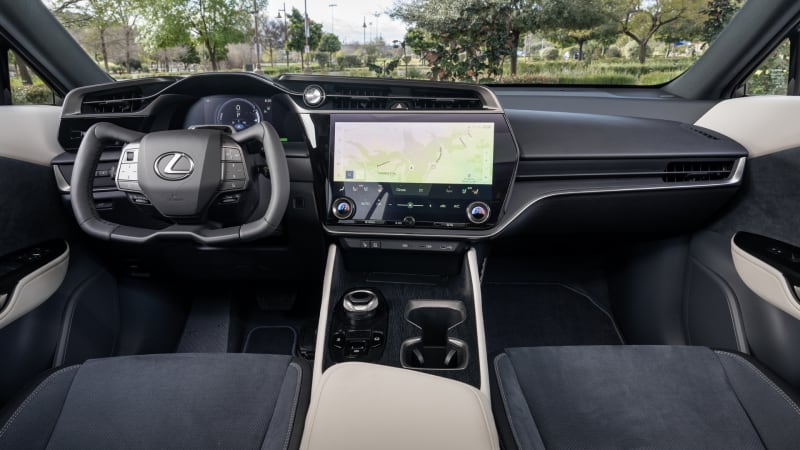The yoke is no joke. For those of you anticipating the new Lexus “Steer by Wire” system and its yoke-like steering contraption to be the most distinctive, forward-looking, and ultimately compelling reason to consider the 2024 Lexus RZ 450e, you would’ve been in the minority. Most of us rolled our eyes, hard, when RZ interior pictures were released. Having seen Tesla’s gimmicky yoke in action, skepticism was understandable. In short, though, this is not just a yoke bolted onto the steering column for drivers to pretend they’re Batman. It is in fact an intrinsic part of an entirely new steering concept that could revolutionize the way we interact with the front wheels of a car. Which is why I’m going to talk about it an awful lot here in the beginning of this RZ review, because, unfortunately, this late-availability option is a much bigger deal than the electric crossover it’s attached to. (Though if you want to skip ahead, click here).
Basically, there is no mechanical connection between the yoke and the front wheels. There’s not even a mechanical backup as Infiniti’s unloved steer-by-wire system had, but before you get too bent out of shape about that, the last airplane you flew on almost certainly was steered by wire with no mechanical backup. It had a yoke, too, for that matter. Anyway, that’s not the big deal.
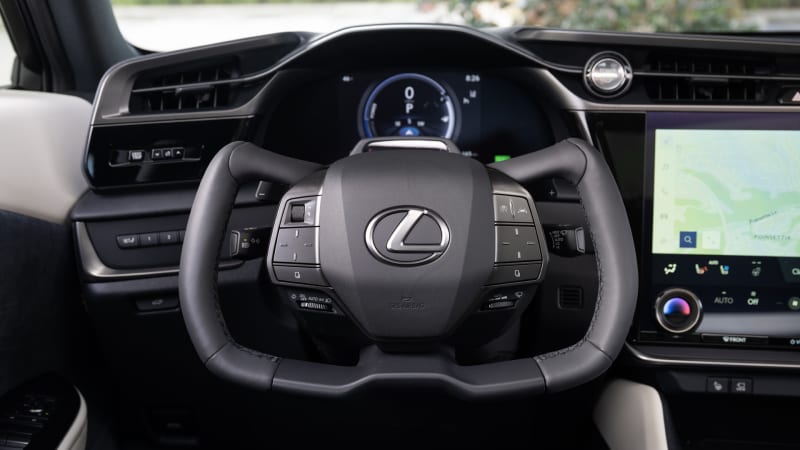
An angle sensor in the column senses how much you turned and sends that info to the usual electric power steering system, while the car determines how fast the car is going. Those two pieces of info are then used to radically alter the steering ratio and therefore how much you have to steer.
For example, if you’re at low speeds in a parking lot or turning right at a stop sign, the amount of steering input you have to provide is minuscule, like turning around a gentle bend at 40 mph. Performing a U-turn only requires turning your right hand over to 11 o’clock with your left hand to 5 – as in less than one full rotation. That’s full-lock with Steer by Wire, which means there’s no reason for you to remove your hands from 3 and 9, and therefore, a steering wheel isn’t strictly necessary and can actually be a detriment – which is why the yoke was devised. If there was a wheel, RZ assistant chief engineer Tatsuya Ishigaki says drivers would likely unnecessarily crank the wheel over – just as I would have when I went to do a left U-turn with the yoke and instinctively brought my left hand over to 2 o’clock only to discover air.
You can see it in action in the video below.
What’s not shown, however, is the far more extensive drive I took afterward in a tight, confined neighborhood (complete with a cute little roundabout) and various gently winding suburban roads. I adapted very quickly to the system, and after jumping back into a regular-wheeled RZ, found myself suddenly surprised by how much wheel turning we typically do. From what I experienced, this is not a gimmick. It actually works, could be considered an improvement, and could easily be the future. The fact that it provides a clearer view to the IP, which is literally relocated higher with the yoke, is a bonus. Now, yes it’s weird at first and you have to reprogram your brain a bit, but if you have an open mind, I don’t think it would take long. Believe me, I’m as surprised by this conclusion as you might be.
Now, some caveats. I did not drive it on a winding mountain road, which I suspect might reveal some oddities and issues. To be continued, then. The turn signal stalk remains (unlike the Tesla yoke that uses buttons), but it is much smaller and mounted to the yoke instead of the column, meaning it was consistently not where I was expecting it to be. It was an issue when quickly turning left after turning right. I was also fine with the yoke because I almost always hold the wheel at 3 and 9 – if you’re a wrist-over-the-top person or a 2-and-10-er, you may not like the yoke. Resting your hands on the bottom works, though.
So that’s the deal with the yoke. Onto the rest of the car. As you can tell just by looking at the thing, the 2023 Lexus RZ 450e uses the same e-TNGA electric vehicle architecture as the Toyota bZ4X and Subaru Solterra. The dimensions are broadly the same, with differences largely the result of design (rear headroom in the Lexus is notably better). Beyond its platform-mates, the RZ is roughly the same length as the Lexus RX midsize SUV, but is closer in height to the compact NX. Passenger space is therefore generous, and cargo capacity seems more functional than its 23.7 cubic-foot volume would indicate. It sure seems comparable to the Genesis GV60, which also belongs to a set of corporate EV triplets (with Kia EV6 and Hyundai Ioniq 5).
That’s where the positive comparisons stop, though, as those triplets are ultimately the elephant in the room – in that they squash the RZ on the spec sheet. Now, it’s terrific that the Lexus RZ 450e features more powerful versions of Toyota’s eAxle (also found at the rear of the Lexus RX 500h) to send 308 horsepower to the front and rear wheels. That’s a clear performance upgrade over the 214-hp bZ4X AWD, and similar to the base GV60. No doubt about it, the RZ goes. Trouble is, it won’t go very far. It has the same 71.4-kilowatt-hour battery pack as the front-wheel-drive bZ4X (long story), which gets either 252 or 242 miles of range depending on trim level. That’s just on the border of what we’d consider acceptable, which should put into perspective the RZ 450e offering 220 miles of range with 18-inch wheels and 196 miles with the optional 20’s. The GV60 is good for 248 miles; the similarly priced BMW i4 eDrive40 can do 301.
And remember, that’s with optimal conditions. It was on the cold and blustery side by San Diego standards during our drive, which among other factors, meant the heater was running. As we set off, the distance-to-empty gauge read 138 miles while the battery gauge showed 85% full. Range anxiety is generally overblown, but you’d be way more likely to suffer from it in the RZ. Worse, its charging capability is average at best. It can manage a maximum 150-kW charging rate, which is admittedly the same as the Ford Mustang Mach-E and many other EVs. Once again, though, the Hyundai triplets and BMW blow it away with speeds topping 200 kW that allow them to take advantage of 350-kW fast chargers. Teslas are superior as well. Also, even if the RZ’s 0-80% recharge time of 30 minutes is decent, remember that it has a smaller battery to fill.
In short, there’s nothing about the RZ’s EV credentials that is anywhere near as forward-thinking and progressive as the Steer by Wire system. It seems like the goal was to provide an EV for those used to driving a Lexus RX, NX or Toyota hybrid, and who would be unlikely to abandon their loyalty. If you already have an EV or are cross-shopping brands, though, you’re bound to find it lacking. Another example of this is the car’s multiple levels of regenerative braking. Yes, it brakes far more than usual for you than a car without heavy regen, and those coming from an RX, etc., should enjoy the benefits in traffic and elsewhere. It is not, however, full one-pedal driving as you’ll get in all the cars mentioned above, and which many EV drivers come to find indispensable.
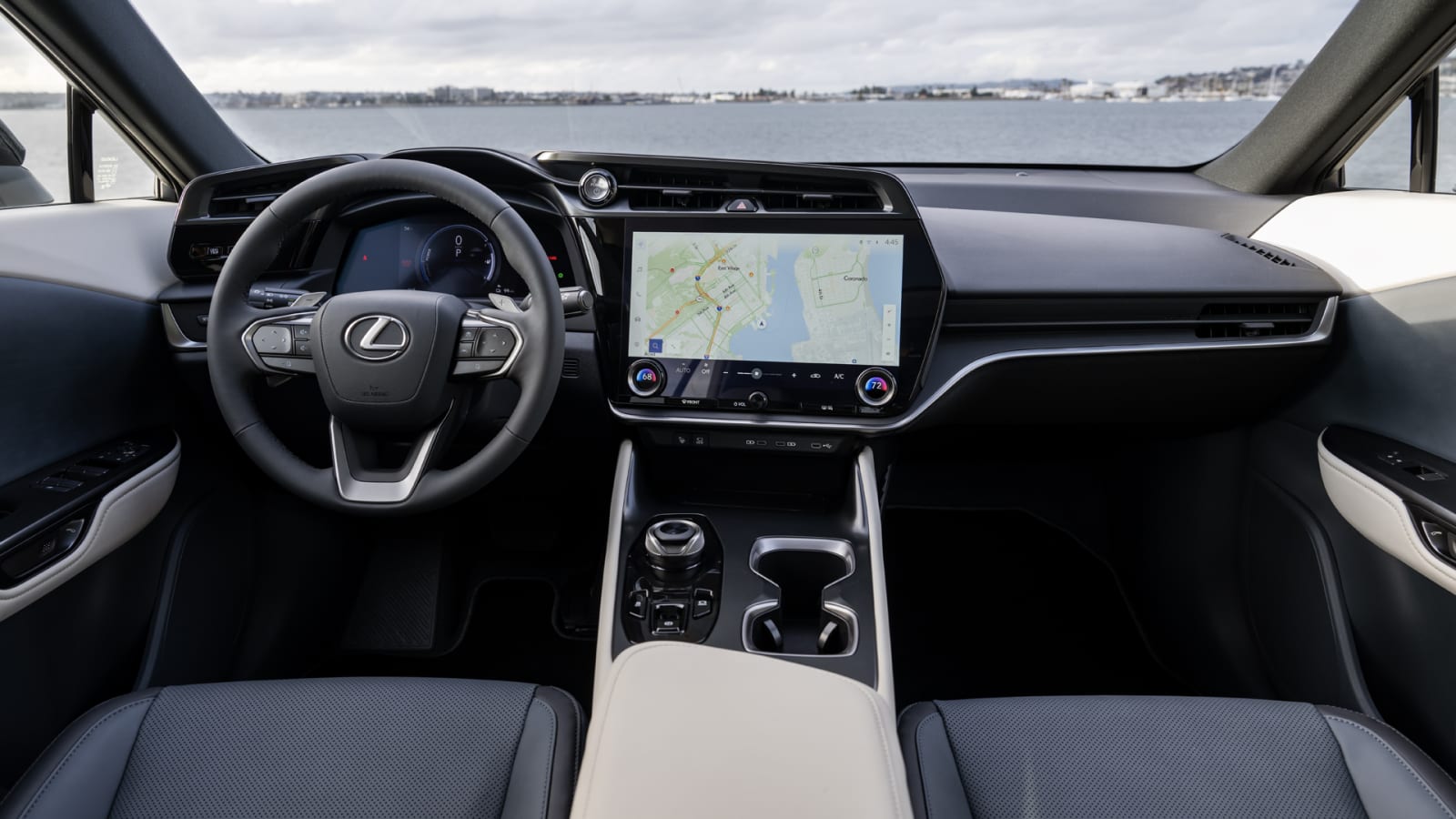
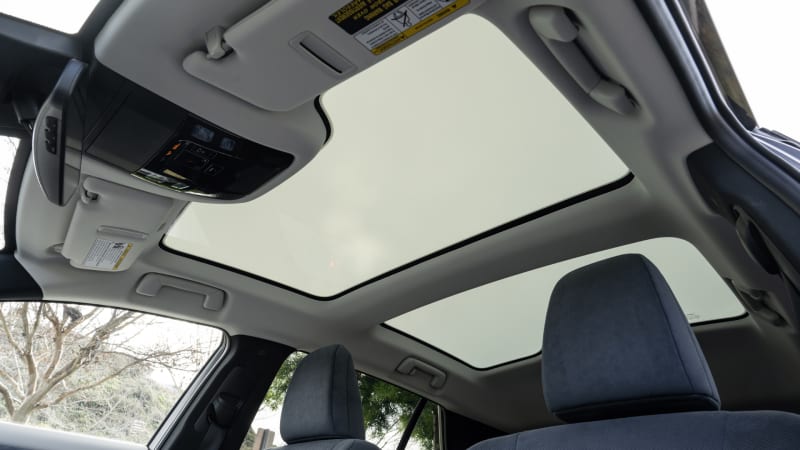
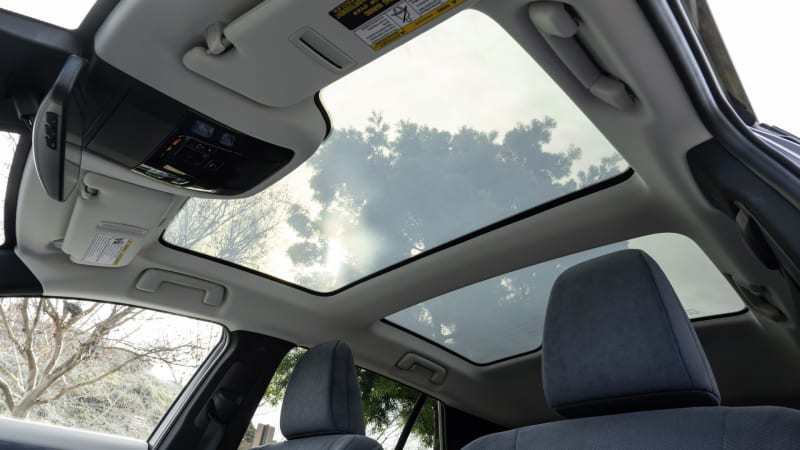
Besides power, the interior is the RZ’s greatest advantage over its electric platform-mates. The materials quality and styling are superior, especially with the Thunderstorm (blue) and Macadamia (white) color scheme and Ultrasuede fabric covering the seats and doors. You can also get a nifty panoramic sunroof with an electrostatic film that makes the glass go opaque at the press of a button. An accessory sunshade is available for even stronger coverage, too.
Another novel feature is the radiant heater option, also available on the bZ4X, that quickly and efficiently heats the cabin directly in front of the driver and front passenger (if present). This not only heats the cabin quicker, but it draws less juice from the battery, which is a big deal in the RZ.
Finally, there’s the matter of price. Our RZ 450e Premium test car, the first of two trim levels, started at $60,890, and with the Technology package and a handful of cheaper options, goes for $63,415. In theory, this price tag in conjunction with the RZ’s size, performance, range and equipment aligns it with the Volvo C40 and Mercedes EQB. Trouble is, the luxury EV bar is higher than those. The similarly powered GV60 Advanced, which comes with more equipment despite zero available options, goes for $60,385. Perhaps a less established brand like Genesis should come with a discount, but there’s no way these two cars should be priced equally. Ditto a BMW i4 eDrive40, even if it’s a rear-wheel-drive car and not an all-wheel-drive SUV-like vehicle. Oh, and a Tesla Model Y starts at $54,990 (well, this week at least) and is eligible for the $7,500 federal tax credit none of the above luxury EVs are due to price and final assembly location (the RZ is built in Japan).
So that would be why the Steer by Wire system left such a lasting impression. It was genuinely impressive and intriguing. Sadly, the RZ 450e is not. Until Steer by Wire arrives later this year, it’s hard to see the RZ being more compelling than the plug-in-hybrid Lexus RX 450h+ or any of the luxury EVs mentioned above.
Related Video:

